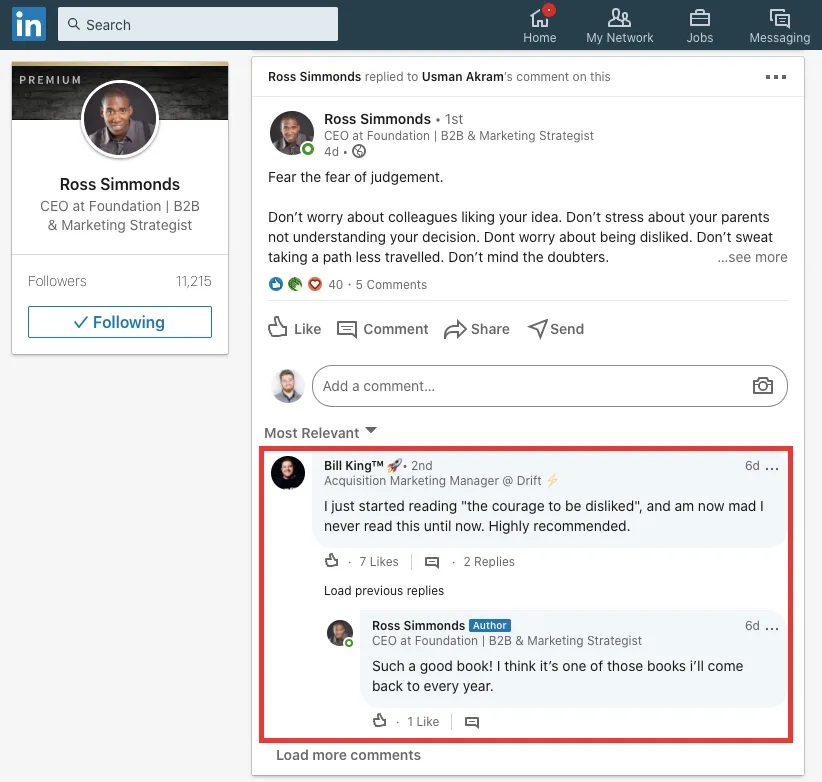
What makes LinkedIn such a great content marketing channel for sales teams, and how can you get the best results from the time you’re investing?
For sales pros, LinkedIn is the place to be.
Don’t believe me? Just look at the latest LinkedIn statistics: 61 million LinkedIn users are senior level influencers, and 40 million are in decision-making positions. That’s 40–60 million people who can pull the trigger on buying what you’re selling.
If you’re trying to connect with the people who make the purchasing decisions (which you should be), LinkedIn is where I’d start.
Beyond the user count, LinkedIn is also one of the best places to share content, period.
- 91% of marketing executives list LinkedIn as the top place to find quality content
- There are 9 billion content impressions in the LinkedIn feed every week
- Only 3 million users share content weekly (out of 500 million+ total users)
Let’s break down these numbers...
Right now, 9/10 marketing executives are looking for content on LinkedIn first. These execs are actively trying to find the content you and your team have been working so hard to create—you just need to deliver it to them.
The LinkedIn feed is also responsible for billions of impressions every week, but you’re only competing with a small subset of LinkedIn’s total user base (<1% sharing content weekly) for those impressions. The majority of LinkedIn users are there to consume content, not share content of their own.
So we know the objective:
Connect with senior level decision-makers on LinkedIn.
Now the question is: How do you pull it off? What can you do to reach these decision-makers while establishing trust and credibility?
I’ve been using LinkedIn as a primary content distribution channel for years now. As a result, I’ve been able to reach:
- 11,215 followers on my personal account
- 54,200 content impressions monthly
- 4 closed deals starting from LinkedIn this year alone
And in this post, I’m going to be sharing some pro tips you (and every sales pro on your team) can use to better connect with prospects through content marketing and content distribution.
Let’s jump in.
(PS: If you’re interested, I’ve also created a free content distribution checklist with over 100 of my favorite tactics across 12 distribution channels—LinkedIn included.)
Use your personal account—often
First things first: Personal accounts win on LinkedIn.
People prefer to connect with other people, not logos—especially during the time they’re choosing to spend on social media.
So instead of only sharing content from the Foundation Marketing company account, I’m also actively sharing and connecting through my own personal account:
 |
I share lessons I’m learning on leading a company, selling content to an executive team, content distribution strategies that are working, etc.—all from my own personal account.
Beyond my own content, I’m also actively monitoring replies and my feed every day. In fact, I have recurring blocks in my calendar at the beginning and end of every day dedicated to engaging on LinkedIn.
Here’s the thing to remember:
It doesn’t have to be business-mode 24/7—actually connect with your prospects.
You’ve heard it hundreds (maybe thousands) of times before, but you need to invest time and effort into connecting with the people you’re trying to get on the phone.
And I’m not talking about the basic cookie-cutter stuff like:
- Comment “Awesome!” on your prospects’ posts
- Like three of their posts, then send a DM
- Share their posts so it looks like you care
I’m talking about building real relationships with prospects—not just the fake transactional connections where you leave them in the dust while the ink is still wet.
The people you’re selling to are also people with hobbies and interests outside of work. If you have interests in common with your prospects, lean on those. Think books, fantasy football, cycling or Fresh Prince reruns (just me?).
If you're looking to expand your network and generate leads on LinkedIn, our prospecting guide is a must-read.
Great example—Drift’s acquisition marketing manager shared a book recommendation in a comment, and I sent a quick reply:
 |
Again, the objective isn’t to sell directly through your LinkedIn posts and comments. The objective is to build personal relationships with the people who can eventually become your champions at their companies.
And to enhance your presence on LinkedIn, remember the importance of a standout profile. Utilizing Close's LinkedIn Headline Generator and LinkedIn Summary Generator can make a significant difference. These intuitive tools assist you in crafting an impactful headline and a compelling summary for your LinkedIn profile. By optimizing these key profile elements, you're better positioned to attract and engage with the decision-makers and influencers among your connections.
Share your best sales enablement content
Sales enablement content is any blog post, comparison page, video, PDF asset, cheatsheet or other resource that’s designed to help you and your sales team sell.
And this content is going to become your best friend on LinkedIn.
For example, the Close team has a page comparing Close vs. other CRMs with a high-level comparison table for each primary competitor:
 |
If your team has something similar available, you can keep it in your back pocket for the next time you see a prospect asking about the different options in your industry.
Here’s another example:
Since we offer content distribution services at Foundation Marketing, we created a guide breaking down what a content distribution strategy is and why brands need one:
 |
This piece has become a fantastic resource for myself and the team to share on LinkedIn when we’re having conversations with prospects about what goes into a great strategy and how we’d recommend approaching the process.
If your sales enablement content library is leaving a lot to be desired, schedule some time with your marketing team to talk about which assets you’d love to have available.
And if your marketing team is full up (or nonexistent), you can also connect with a content marketing agency for some strategic and executional support.
Curious about AI's impact on 10X content marketing? Find answers in our article.
Use LinkedIn Sales Navigator to simplify the process
For sales pros, using Sales Navigator can make the LinkedIn relationship building process 10x easier overnight.
With Sales Navigator, you can set up filtered searches and prospect lists so you see only the people and relationships you want to prioritize at the moment.
 |
This way, instead of sorting through 1,000+ connections just to find out whether your prospects have shared anything recently—it’ll all be right in front of you.
Use these pre-filtered feeds to catch when prospects are sharing posts, then be one of the first to respond with a genuine reaction, follow-up question or thoughtful comment.
Wrapping up
LinkedIn is where the decision-makers hang out.
It’s where they’re going for content recommendations. It’s where they’re going to connect with colleagues and others in the industry. It’s where you can build relationships that aren’t just transactional.
And to help you get up and running, here’s a quick recap of my top three tips for every sales pro getting started on LinkedIn:
- Use your personal account (and actually build connections)
- Share your best sales enablement content
- Set up Sales Navigator to simplify the processAnd if you want to sink your teeth even further into content distribution, download my free content distribution checklist with 100+ tactics you can start using right away.
Uncover the secret weapon for sales professionals: Boolean search on LinkedIn. Gain a competitive edge by reading our article, "Boolean Search on LinkedIn: The Sales Superpower You Need to Boost Your Outbound Pipeline."










